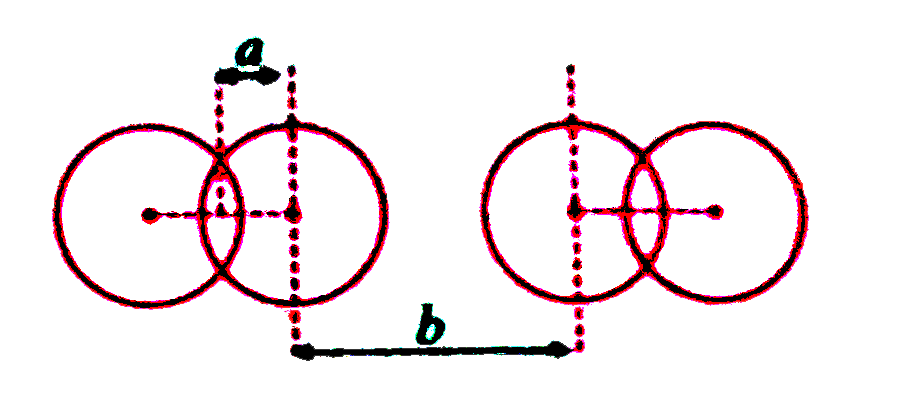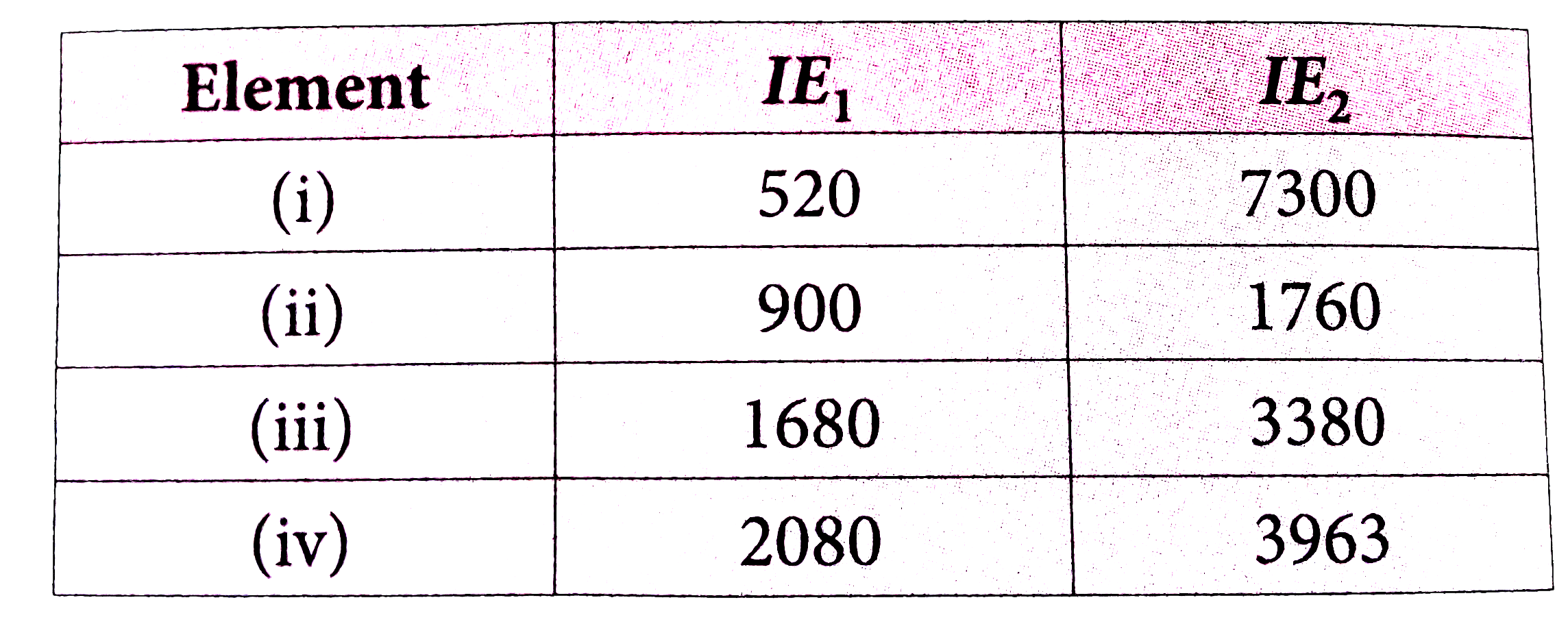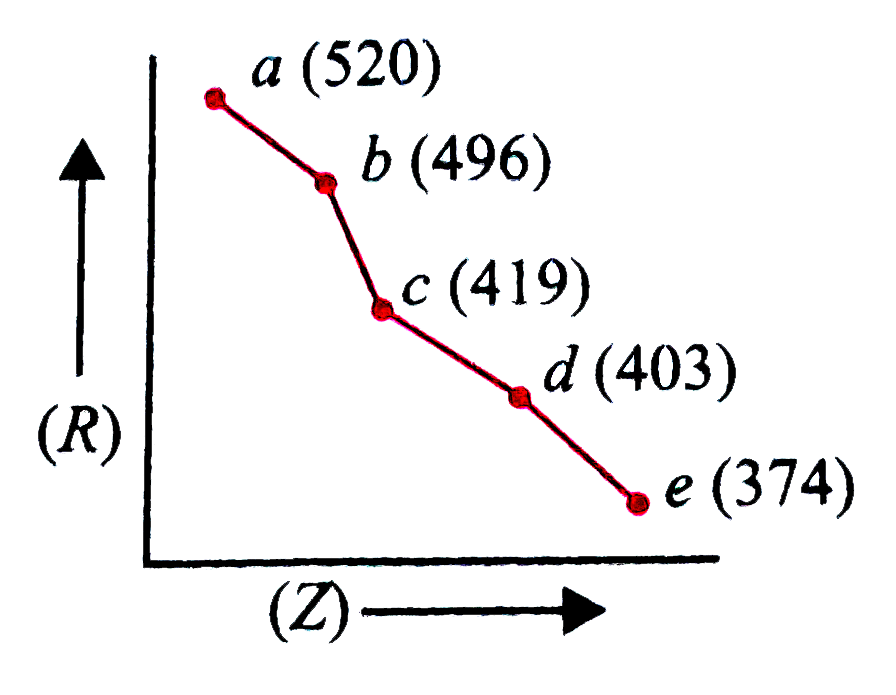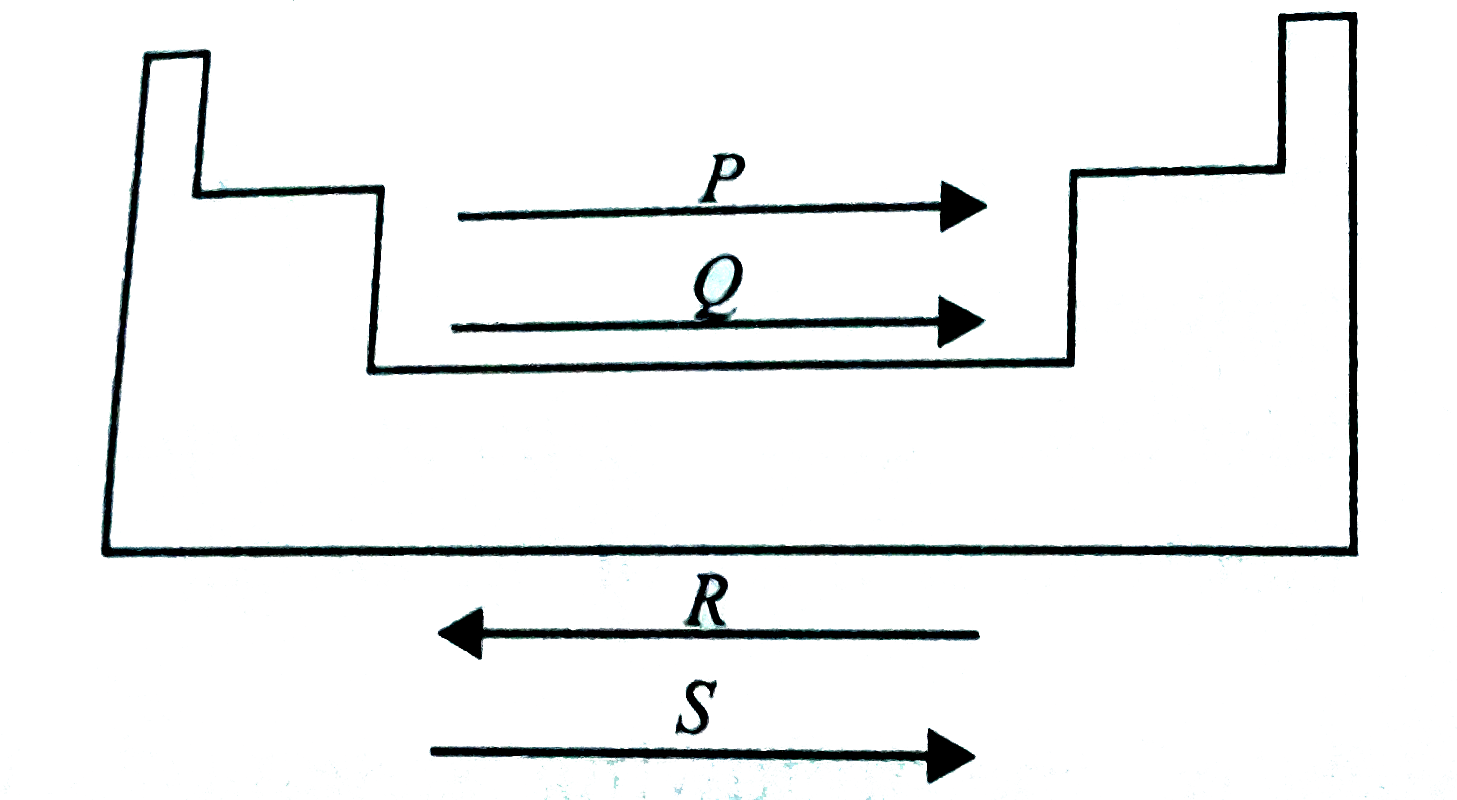Complete Solutions to Periodic Trends In Properties Of Elements of chapter CLASSIFICATION OF ELEMENTS AND PERIODICITY of Class 11 book with complete answers and questions
| Class 11 | CHEMISTRY |
| Chapter | CLASSIFICATION OF ELEMENTS AND PERIODICITY |
| NCERT FINGERTIPS | Periodic Trends In Properties Of Elements |
| Number Of Questions | 59 |
| Academic Year | 2023-24 |
What are the two radii shown as'a' and 'b' in the figure known as?

View SolutionFew values are given in the table in the direction from left to right and top to bottom.Predict the property which could be depicted in the table.

View SolutionWhich of the following statements regarding the variation of atomic radii in the periodic table is true?
View SolutionIonic radius a group while moving down
View Solution`K^(+)` and `Cl^(-)` ions are isoelectronic.Which of the statement is not correct?
View SolutionWhich one of the following groups represent a collection of isolectronic species ? (At.no `Cs = 55, Br = 35)`
View SolutionWhich of the following transitions involves maximum amount of energy?
View SolutionWhat is the order of successive ionisation enthalpies?
View SolutionWhich group of elements shows lowest ionisation enthalpy?
View SolutionThe first ionisation enthalpy of the elements C,N,P,Si are in the order of
View SolutionThe ionisation energy of nitrogen is more than that of oxygen because
View Solutionwhich of the following elements has the highest value of second ionization energy?
View SolutionWhich of the following can most easily form unipositive gaseous ion?
View SolutionAmongst the metal Be, Mg, Ca and Sr of group 2 of the periodic table, the least ionic chloride would be formed by
View SolutionBeryllium has higher ionisation enthalpy than boron.This can be explained as,
View SolutionA sudden large jump between the values of second and third ionisation energies of an element would be associated with the electronic configuration
View SolutionFew elements are matched with their successive ionisation energies,Identify the elements.

View SolutionFirst and second ionisation enthalpies(in KJ/mol) of few elements are given below:

Which of the above elements will form halides with formula `MX_(2)`?
View SolutionIonization enthalpies of transition metals are
View SolutionConsider these electronic configurations for neutral atoms:
(i) `1s^(2)2s^(2)2p^(6)3s^(1)`
(ii). `1s^(2)2s^(2)2p^(6)4s^(1)`
Which of the following statements is/are false?
View SolutionWhich of the following element will have highest ionization energy?
View SolutionFew values of enthalpies are given below: `O=-141 KJ mol^(-1)`
`F= -328 KJ mol^(-1)`
`S= -200 KJ mol^(-1)`
`Cl= -349 KJ mol^(-1)` What do these values show?
View SolutionIn the given graph,a periodic property (R) is plotted against atomic number(Z) of the elements.Which property is shown in the graph and how it is correlated with reactivity of the elements?

View SolutionWhich is correct increasing order of their tendency of the given elements to from `M^(3-)` ion?
View SolutionWhich of the following have least electron affinity?
View SolutionWhich one of the following arrangements represents the correct order of electron gain enthalpy of the given atomic species?
View SolutionWhich of the following statements is not correct about the electron gain enthalpy?
View SolutionWhy is the electron gain enthalpy of O or F less than that of S or Cl?
View SolutionWhich of the following statements regarding an anion is not true?
View SolutionWhich of the following properties of isotopes of an element is different?
View SolutionGiven below are the names of new elements based on their position in the periodic table.Identify the element which is not correctly placed.
View SolutionWhich of the following noble gases has the maximum positive electron gain enthalpy?
View SolutionAn atom with high electronegativity has
View SolutionStudy the given diagram of the periodic table and fill the blanks with appropriate choice.

View SolutionWhich of the following is not a periodi0c property for the elements?
View SolutionFill in the blanks with appropriate option the ability of an atom to attract shared electrons to itself is called_(i)_.It is generally measured on the_(ii)_scale.An arbitrary value of_(iii)_is assigned to fluorine (have greatest ability to attract electrons). It generally_(iv)_across a period and _(v)_down a group.
View SolutionWhich of the following options are not in accordance with the property mentioned against them ?
View SolutionChoose the incorrect statement.
View SolutionFollowing statements regarding the periodic trends of chemical reactivity of the alkali metals and the halogens are given. Which of these statements gives the correct picture: A)In alkali metals the reactivity increases but in the halogens it decreases with increase in atomic number down the group B)The reactivity decreases in the alkali metals but increases in the halogens with increases in atomic number down the group. C)In both the alkali metals and the halogen the chemical reactivity decreases with increases in atomic number down the group D)Chemical reactivity increases with increases in atomic number down the group in both the alkali metals and halogens.
View SolutionAn element X has atomic number 19.What will be the formula of its oxide?
View SolutionAn element 'P' has atomic number 56. What will be the formula of its halide?
View SolutionPredict the formula of stable compound formed by an element with atomic number 114 and fluorine.
View SolutionPredict the formula of a compound formed by aluminium and sulphur.
View SolutionThere are many elements in the periodic table which exhibit variable valency.This is a particular characteristic of
View SolutionPredict the formula of the stable binary compounds that would be formed by the combination of the following pairs of elements.
a.Lithium and oxygen
b. Magnesium and nitrogen
c. Aluminium and iodine
d. Silicon and oxygen
e. Phosphorus and fluorine
f. Element `71` and fluorine
View SolutionThe oxidation state of an element in a particular compound can be defined as
View SolutionThe first element of the group 1 and 2 are different from other members of the respective group.Their behaviour is more similar to the second element of the following groups,What is this relationship known as ?
View SolutionWhich of the following statements is true about the variation of density of elements in the periodic table?
View SolutionThe main reason for showing anomalous properties of the first member of a group in s or p-block is
View SolutionWhen we move from left to right in a period electropositive charcter
View SolutionWhich one of the following oxides is neutral ? A)`CO` B)`SnO_(2)` C)`ZnO` D)`SiO_(2)`
View SolutionWhat is the common property of the oxides CO,NO and `N_(2)O`?
View SolutionThe correct order of acidic character of oxides in third period of periodic table is
View SolutionWhich of the following oxides is amphoteric is nature ?
View Solution(a),(b) and (c) are elements in the second short period. Oxide of (a) is ionic, that of (b) is amphoteric and of (c) of gaint molecule. (a),(b) and (c) have atomic number in the order-
View SolutionConsider the following species:
`N^(3-)`,`O^(2-)`,`F^(ө)`,`Na^(o+)`,`Mg^(2+)` and `Al^(3+)`
a. What is common in them?
b. Arrange them in the order of increasing ionic radii.
View SolutionWhich of the following is arranged in order of increasing metallic character?
View SolutionThe most electropositive element is
View SolutionAmong the elements with atomic number 9, 12, 16 and 36 which is highly electropositive ?
View Solution
Periodic Trends In Properties Of Elements questions and complete solutions for chapter CLASSIFICATION OF ELEMENTS AND PERIODICITY of MTG CHEMISTRY (HINGLISH) of Class 11
All Exercises from NCERT FINGERTIPS Class 11 CHEMISTRY CLASSIFICATION OF ELEMENTS AND PERIODICITY
- Assertion And Reason
- Electronic Configuration And Type Of Elements
- Electronic Configuration Of Elements And Periodic Table
- Genesis Of Periodic Classification
- Higher Order Thinking Skills
- Modern Periodic Law And Present Form Of Periodic Table
- NCERT Exemplar
- Nomenclature Of Elements
- Periodic Trends In Properties Of Elements